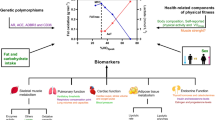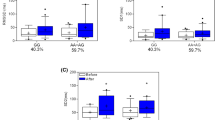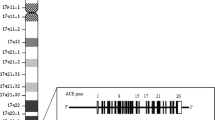Abstract
The insertion (I) variant of the angiotensin-1 converting enzyme (ACE) I/D genetic polymorphism is associated with lower circulating and tissue ACE activity. Some studies have also suggested associations of ACE I/D genotype with endurance phenotypes. This study assessed the relationships between circulating ACE activity, ACE I/D genotype, mechanical efficiency and the maximal rate of oxygen uptake in sedentary individuals. Sixty-two untrained women were tested for mechanical efficiency during submaximal cycle ergometry (delta and gross efficiencies during exercise between 40 and 80 W) and the maximal rate of oxygen uptake during incremental treadmill running. Respiratory variables were measured using indirect calorimetry. Venous blood was obtained for direct assay of circulating ACE activity, allowing for the assessment of correlations between two continuous variables, rather than a categorical analysis of endurance phenotype by genotype alone. ACE I/D genotype was also determined, and was strongly associated with circulating ACE activity (P < 0.0005). Neither circulating ACE activity (27.4 ± 8.4 nM His-Leu-ml−1) nor ACE genotype showed a statistically significant association with any of the endurance phenotypes measured. The weak correlations observed included r = −0.122 (P = 0.229) for the relationship between delta efficiency (23.9 ± 2.5%) and circulating ACE activity and r = 0.134 (P > 0.6) for the relationship between maximal aerobic power (149.1 ± 22.9 ml kg−2/3 min−1) and circulating ACE activity. The data do not support a role for systemic ACE activity in the regulation of endurance performance in sedentary individuals, extending this observation to a large female cohort.


Similar content being viewed by others
References
Bahi L, Koulmann N, Sanchez H, Momken I, Veksler V, Bigard AX, Ventura-Clapier R (2004) Does ACE inhibition enhance endurance performance and muscle energy metabolism in rats? J Appl Physiol 96:59–64
BASES (1997) The British Association of Sport and Exercise Sciences Physiological Testing Guidelines. BASES, Leeds
Brouwer E (1957) On simple formulae for calculating the heat expenditure and the quantities of carbohydrate and fat oxidised in metabolism of men and animals, from gaseous exchange (oxygen intake and carbonic acid output) and urine-N. Acta Physiol Pharmacol Neerlandica 6:795–802
Bryner RW, Toffle RC, Ullrich IH, Yeater RA (1996) Effect of low dose oral contraceptives on exercise performance. Br J Sports Med 30:36–40
Cox R, Bouzekri N, Martin S, Southam L, Hugill A, Golamaully M, Cooper R, Adeyemo A, Soubrier F, Ward R, Lathrop GM, Matsuda F, Farrall M (2002) Angiotensin-1-converting enzyme (ACE) plasma concentration is influenced by multiple ACE-linked quantitative trait nucleotides. Hum Mol Genet 11:2969–2977
Cushman DW, Cheung HS (1971) Concentrations of angiotensin-converting enzyme in tissues of the rat. Biochim Biophys Acta 250:261–265
Danser AH, Schalekamp MA, Bax WA, van den Brink AM, Saxena PR, Riegger GA, Schunkert H (1995) Angiotensin-converting enzyme in the human heart. Effect of the deletion/insertion polymorphism. Circulation 92:1387–1388
Depierre D, Roth M (1975) Fluorimetric determination of dipeptidyl carboxypeptidase. (angiotensin- I-converting enzyme). Enzyme 19:65–70
Dzau VJ (1988) Tissue renin–angiotensin system: physiologic and pharmacologic implications. Introduction. Circulation 77:I1–I3
Dzau VJ, Bernstein K, Celermajer D, Cohen J, Dahlof B, Deanfield J, Diez J, Drexler H, Ferrari R, van Gilst W, Hansson L, Hornig B, Husain A, Johnston C, Lazar H, Lonn E, Luscher T, Mancini J, Mimran A, Pepine C, Rabelink T, Remme W, Ruilope L, Ruzicka M, Schunkert H, Swedberg K, Unger T, Vaughan D, Weber M (2001) The relevance of tissue angiotensin-converting enzyme: manifestations in mechanistic and endpoint data. Am J Cardiol 88:1L–20L
Fagard R, Lijnen P, Vanhees L, Amery A (1982) Hemodynamic response to converting enzyme inhibition at rest and exercise in humans. J Appl Physiol 53:576–581
Gaesser GA, Brooks GA (1975) Muscular efficiency during steady-rate exercise: effects of speed and work rate. J Appl Physiol 38:1132–1139
Gayagay G, Yu B, Hambly B, Boston T, Hahn A, Celermajer DS, Trent RJ (1998) Elite endurance athletes and the ACE I allele–the role of genes in athletic performance. Hum Genet 103:48–50
Geisterfer AA, Peach MJ, Owens GK (1988) Angiotensin II induces hypertrophy, not hyperplasia, of cultured rat aortic smooth muscle cells. Circ Res 62:749–756
Giudicelli JF, Richer C, Richard C, Thuillez C (1991) Angiotensin converting enzyme inhibition. Systemic and regional hemodynamics in rats and humans. Am J Hypertens 4:258S–262S
Gordon SE, Davis BS, Carlson CJ, Booth FW (2001) ANG II is required for optimal overload-induced skeletal muscle hypertrophy. Am J Physiol 280:E150–E159
Hagberg JM, Ferrell RE, McCole SD, Wilund KR, Moore GE (1998) VO2 max is associated with ACE genotype in postmenopausal women. J Appl Physiol 85:1842–1846
Ishigai Y, Mori T, Ikeda T, Fukuzawa A, Shibano T (1997) Role of bradykinin-NO pathway in prevention of cardiac hypertrophy by ACE inhibitor in rat cardiomyocytes. Am J Physiol 273:H2659–H2663
Janse de Jonge XA (2003) Effects of the menstrual cycle on exercise performance. Sports Med 33:833–851
Jeunemaitre X, Lifton RP, Hunt SC, Williams RR, Lalouel JM (1992) Absence of linkage between the angiotensin converting enzyme locus and human essential hypertension. Nat Genet 1:72–75
Lebrun CM, Petit MA, McKensie DC, Taunton JE, Prior JC (2003) Decreased maximal aerobic capacity with use of a triphasic oral contraceptive in highly active women: a rendomised controlled trial. Br J Sports Med 37:315–320
McArdle WD, Katch FI, Katch VL (2001) Exercise physiology: energy, nutrition and human performance. Lippincott, Williams and Wilkins, Philidelphia
Mittleman KD (1996) Influence of angiotensin II blockade during exercise in the heat. Eur J Appl Physiol Occup Physiol 72:542–547
Montgomery HE, Clarkson P, Dollery CM, Prasad K, Losi MA, Hemingway H, Statters D, Jubb M, Girvain M, Varnava A, World M, Deanfield J, Talmud P, McEwan JR, McKenna WJ, Humphries S (1997) Association of angiotensin-converting enzyme gene I/D polymorphism with change in left ventricular mass in response to physical training. Circulation 96:741–747
Montgomery HE, Marshall R, Hemingway H, Myerson S, Clarkson P, Dollery C, Hayward M, Holliman DE, Jubb M, World M, Thomas EL, Brynes AE, Saeed N, Barnard M, Bell JD, Prasad K, Rayson M, Talmud PJ, Humphries SE (1998) Human gene for physical performance. Nature 393:221–222
Montgomery H, Humphries S, Danilov S (2002) Is genotype or phenotype the better tool for investigating the role of ACE in human cardiovascular disease? Eur Heart J 23:1083–1086
Murphey LJ, Gainer JV, Vaughan DE, Brown NJ (2000) Angiotensin-converting enzyme insertion/deletion polymorphism modulates the human in vivo metabolism of bradykinin. Circulation 102:829–832
Myerson S, Hemingway H, Budget R, Martin J, Humphries S, Montgomery H (1999) Human angiotensin I-converting enzyme gene and endurance performance. J Appl Physiol 87:1313–1316
Nevill AM, Atkinson G (1997) Assessing agreement between measurements recorded on a ratio scale in sports medicine and sports science. Br J Sports Med 31:314–318
Nevill AM, Ramsbottom R, Williams C (1992) Scaling physiological measurements for individuals of different body size. Eur J Appl Physiol Occup Physiol. 65(2):110–117
Rankinen T, Perusse L, Gagnon J, Chagnon YC, Leon AS, Skinner JS, Wilmore JH, Rao DC, Bouchard C (2000a) Angiotensin-converting enzyme ID polymorphism and fitness phenotype in the HERITAGE Family Study. J Appl Physiol 88:1029–1035
Rankinen T, Wolfarth B, Simoneau J-A, Maier-Lenz D, Rauramaa R, Rivera MA, Boulay MR, Chagnon YC, Perusse L, Keul J, Bouchard C (2000b) No association between the angiotensin-converting enzyme ID polymorphism and elite endurance athlete status. J Appl Physiol 88:1571–1575
Reneland R, Lithell H (1994) Angiotensin-converting enzyme in human skeletal muscle. A simple in vitro assay of activity in needle biopsy specimens. Scand J Clin Lab Invest 54:105–111
Rigat B, Hubert C, Alhenc-Gelas F, Cambien F, Corvol P, Soubrier F (1990) An insertion/deletion polymorphism in the angiotensin I-converting enzyme gene accounting for half the variance of serum enzyme levels. J Clin Invest 86:1343–1346
Shen W, Xu X, Ochoa M, Zhao G, Bernstein RD, Forfia P, Hintze TH (2000) Endogenous nitric oxide in the control of skeletal muscle oxygen extraction during exercise. Acta Physiol Scand 168:675–686
Silvestre JS, Bergaya S, Tamarat R, Duriez M, Boulanger CM, Levy BI (2001) Proangiogenic effect of angiotensin-converting enzyme inhibition is mediated by the bradykinin B(2) receptor pathway. Circ Res 89:678–683
Tiret L, Poirier O, Nicaud V, Barbaux S, Herrmann SM, Perret C, Raoux S, Francomme C, Lebard G, Tregouet D, Cambien F (2002) Heterogeneity of linkage disequilibrium in human genes has implications for association studies of common diseases. Hum Mol Genet 11 419–429
Unger T, Schull B, Rascher W, Lang RE, Ganten D (1982) Selective activation of the converting enzyme inhibitor MK 421 and comparison of its active diacid form with captopril in different tissues of the rat. Biochem Pharmacol 31:3063–3070
Williams AG, Rayson MP, Jubb M, World M, Woods DR, Hayward M, Martin J, Humphries SE, Montgomery HE (2000) The ACE gene and muscle performance. Nature 403:614
Williams AG, Dhamrait SS, Wootton PTE, Day SH, Hawe E, Payne JR, Myerson SG, World M, Budgett R, Humphries SE, Montgomery HE (2004) Bradykinin receptor gene variant and human physical performance. J Appl Physiol 96:938–942
Williams AG, Day SH, Folland JP, Gohlke P, Dhamrait S, Montgomery HE (2005) Circulating angiotensin converting enzyme activity is correlated with muscle strength. Med Sci Sports Exerc 37:944–948
Woods DR, World M, Rayson MP, Williams AG, Jubb M, Jamshidi Y, Hayward M, Mary DASG, Humphries SE, Montgomery HE (2002) Endurance enhancement related to the human angiotensin I-converting enzyme I-D polymorphism is not due to differences in the cardiorespiratory response to training. Eur J Appl Physiol 86:240–244
Zannad F, van den Broek SA, Bory M (1992) Comparison of treatment with lisinopril versus enalapril for congestive heart failure. Am J Cardiol 70:78C–83C
Zhang B, Tanaka H, Shono N, Miura S, Kiyonaga A, Shindo M, Saku K (2003) The I allele of the angiotensin-converting enzyme gene is associated with an increased percentage of slow-twitch type I fibers in human skeletal muscle. Clin Genet 63:139–144
Acknowledgments
This study was supported by a grant from The Sir Jules Thorn Charitable Trust. SSD was supported by British Heart Foundation Grant FS/2001044, with work carried out at the Centre for Cardiovascular Genetics, British Heart Foundation Laboratories, Royal Free & University College London Medical School, London, UK.
Author information
Authors and Affiliations
Corresponding author
Rights and permissions
About this article
Cite this article
Day, S.H., Gohlke, P., Dhamrait, S.S. et al. No correlation between circulating ACE activity and \( {\user2{V}}{\mathbf{O}}_{{{\mathbf{2}}_{{{\mathbf{max}}}} }} \) or mechanical efficiency in women. Eur J Appl Physiol 99, 11–18 (2007). https://doi.org/10.1007/s00421-006-0309-3
Accepted:
Published:
Issue Date:
DOI: https://doi.org/10.1007/s00421-006-0309-3




